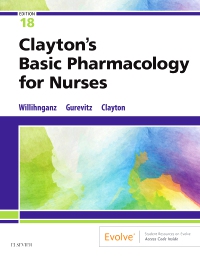
Basic Pharmacology for Nurses - Elsevier eBook on VitalSource, 18th Edition
Elsevier eBook on VitalSource

Now $80.74
Master the basic principles of pharmacology and safe medication administration with Clayton’s Basic Pharmacology for Nurses, 18th Edition. Known for its impeccably accurate and up-to-date drug content, this best-selling text consistently underscores medication safety as it guides you in applying pharmacology information to the nursing process. Introductory units acquaint you with the basic principles of pharmacology and medication administration, while subsequent body-system units prepare you to apply the nursing process to every major disorder. Clear guidelines cover safe drug handling, the types of drugs used for disorders or to affect body systems, injection and enteral administration, and patient education. From a respected author team, this full-color text also provides an excellent review for the pharmacology questions on the NCLEX® examination.
Newer Edition Available
Clayton’s Basic Pharmacology for Nurses - Elsevier eBook on VitalSource
-
- Medication safety is underscored through Medication Safety Alerts and Clinical Pitfall boxes, as well as Do-Not-Confuse and High Alert icons.
- Unit on medication administration clearly and visually outlines assessment, techniques, procedures, and documentation for safe administration of percutaneous, enteral, and parenteral drugs.
- Application of the nursing process offers an overview of general principles of nursing care for each disorder as well as specific nursing considerations for the drug treatment.
- Lifespan Considerations boxes for children and for older adults draw attention to information that would be especially important when giving a specific drug to patients of those age groups.
- Drug tables clearly outline generic and brand names, availability, and dosage ranges for key medications for each disorder.
- Clinical Goldmine boxes focus on best practices in the clinical setting.
- Get Ready for the NCLEX® Examination! section at the end of each chapter covers key points from the chapter as well as review questions to help prepare for course assessments and the NCLEX Examination.
- Video clips on medication administration procedures provide a visual reference for safe medication administration.
- Key terms with phonetic pronunciations and text page references are listed at the beginning of each chapter.
-
- NEW! Chapter on Neurodegenerative Disorders covers drugs for dementia and Alzheimer’s Disease.
- NEW! Updated guidelines on diabetes, heart failure, asthma, COPD, and cancer ensure readers are versed in the latest treatment protocols.
- NEW! Accurate and up-to-date coverage includes the most recent FDA approvals, withdrawals, therapeutic uses, and content on cultural considerations related to each drug class.
-
Unit 1: Applying Pharmacology to Nursing Practice
1. Drug Definitions, Standards, and Information Sources
2. Basic Principles of Drug Action and Drug Interactions
3. Drug Action Across the Life Span
4. The Nursing Process and Pharmacology
5. Patient Education to Promote Health
Unit 2: Illustrated Atlas of Medication Administration
6. Principles of Medication Administration and Medication Safety
7. Percutaneous Administration
8. Enteral Administration
9. Parenteral Administration: Safe Preparation of Parenteral Medications
10. Parenteral Administration: Intradermal, Subcutaneous, and Intramuscular Routes
11. Parenteral Administration: Intravenous Route
Unit 3: Drugs Affecting the Autonomic and Central Nervous Systems
12. Drugs Affecting the Autonomic Nervous System
13. Drugs Used for Sleep
14. Drugs Used for Neurodegenerative Disorders (NEW!)
15. Drugs Used for Anxiety Disorders
16. Drugs Used for Depressive and Bipolar Disorders
17. Drugs Used for Psychoses
18. Drugs Used for Seizure Disorders
19. Drugs Used for Pain Management
Unit 4: Drugs Affecting the Cardiovascular System
20. Introduction to Cardiovascular Disease and Metabolic Syndrome
21. Drugs Used to Treat Dyslipidemias
22. Drugs Used to Treat Hypertension
23. Drugs Used to Treat Dysrhythmias
24. Drugs Used to Treat Angina Pectoris
25. Drugs Used to Treat Peripheral Vascular Disease
26. Drugs Used to Treat Thromboembolic Disorders
27. Drugs Used to Treat Heart Failure
28. Drugs Used for Diuresis
Unit 5: Drugs Affecting the Respiratory System
29. Drugs Used to Treat Upper Respiratory Disease
30. Drugs Used to Treat Lower Respiratory Disease
Unit 6: Drugs Affecting the Digestive System
31. Drugs Used to Treat Oral Disorders
32. Drugs Used to Treat Gastroesophageal Reflux and Peptic Ulcer Disease
33. Drugs Used to Treat Nausea and Vomiting
34. Drugs Used to Treat Constipation and Diarrhea
Unit 7: Drugs That Affect the Endocrine System
35. Drugs Used to Treat Diabetes Mellitus
36. Drugs Used to Treat Thyroid Disease
37. Corticosteroids
38. Gonadal Hormones
Unit 8: Drugs Affecting the Reproductive System
39. Drugs Used in Obstetrics
40. Drugs Used in Men’s and Women’s Health
Unit 9: Drugs Affecting Other Body Systems
41. Drugs Used to Treat Disorders of the Urinary System
42. Drugs Used to Treat Glaucoma and Other Eye Disorders
43. Drugs Used to Treat Cancer 44. Drugs Used to Treat the Musculoskeletal System
45. Drugs Used to Treat Infection
Unit 10: Drugs Affecting the General Health of the Body
46. Nutrition
47. Herbal and Dietary Supplemental Therapy
48. Substance Abuse
Bibliography


